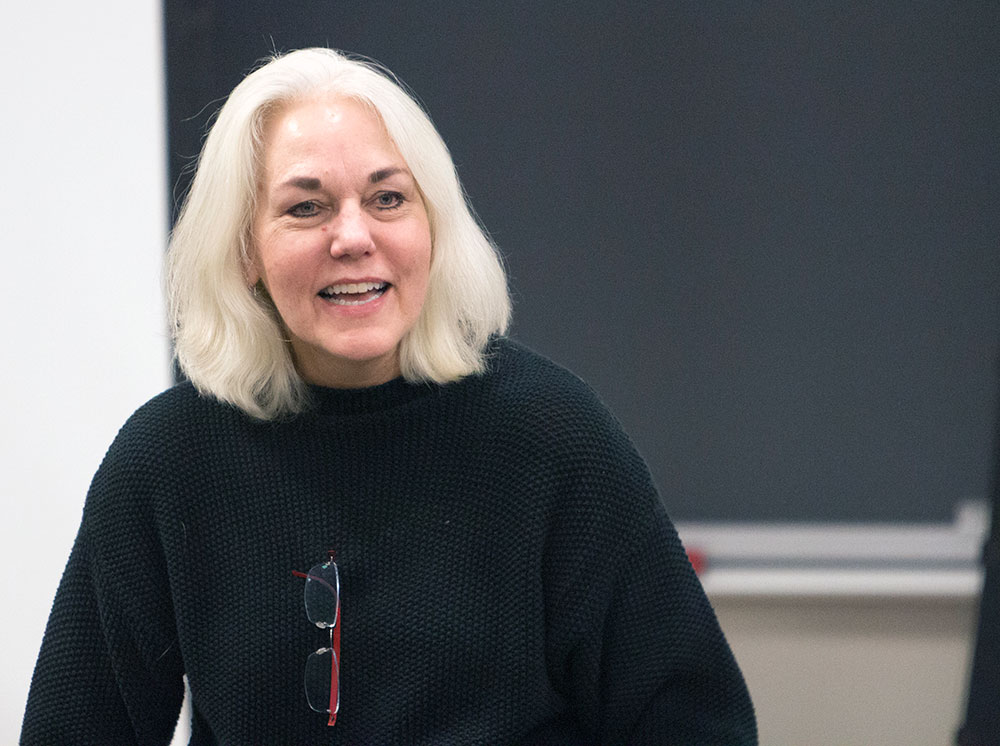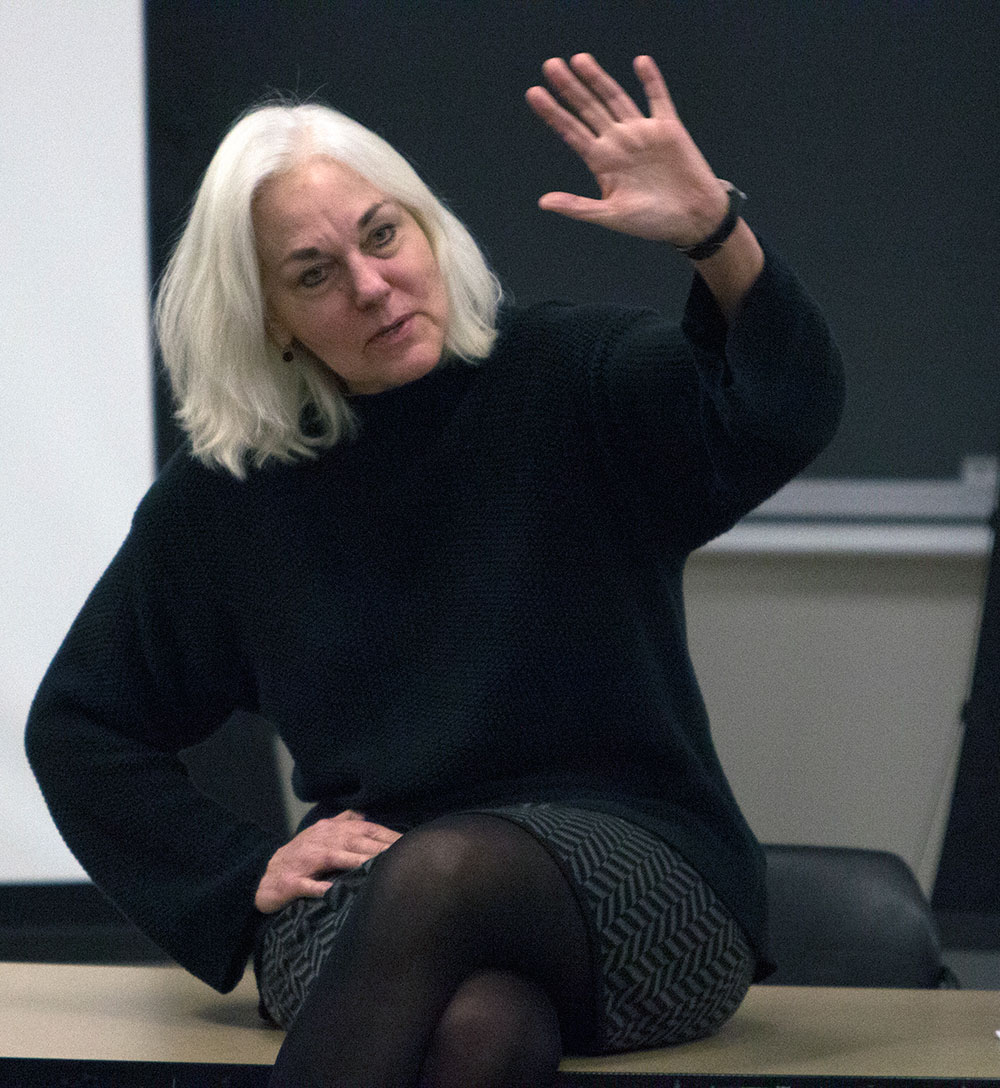Pulitzer-winner Banaszynski urges reporters to have ‘courage to care’

Pulitzer Prize-winning journalism Jacqui Banaszynski told young journalists that reporting requires considering their sources’ points of view and retaining their own humanity.
“I want to make my audience feel something,” she said, speaking of her body of work, including the 1988 Pulitzer Prize-winning feature series, “AIDS in the Heartland.” “You learn to find stories buried in the institutions, the human side.”
Banaszynski, now professor and Knight Chair at the University of Missouri School of Journalism, spoke to professor of practice Tom French’s Behind the Prize class Wednesday afternoon in the Ernie Pyle Hall auditorium. The class brings winners or finalists of prestigious prizes to talk with students nearly every week.
Banaszynski, who also was a Pulitzer finalist 1986, said she didn’t always want to be a journalist. At first she wanted to be a pilot or an athlete, but growing up, women at that time had trouble accessing those opportunities. Instead, when she was 15, she started banging out sports stories on a 1926 Woodstock typewriter, using her notebook as a “ticket to the game” she couldn’t play. Reporting, she said, gave her license to go places she’d never be able to go otherwise.
She said she found writing to be painful, difficult and lonely. It was only “paragraph by paragraph” that she improved — and she did a lot of her improving while at small Minnesota papers right out of college. She spent much of her time covering local government and had little time to indulge in stories that naturally interested her. But the experience taught her how “to get interested in everything.”
“One of the best lessons I got as a young reporter was on a story on curb cuts,” Banaszynski said of the ramps from sidewalks to street level. “Who cares about those? But my editor said, ‘you get your ass in a wheelchair and roll downtown and see how easy it is.’”

And so she became interested in curb cuts, as well as developed an open mind to stories that seemed mundane at first, but have the potential to be meaningful to her audience.
Drawing on her years as a reporter and editor, she reminded students to return to three basic tenants: craft, courage and compassion.
Especially in the age of the Internet, or “open stone-throwing season,” students need to focus acutely on craft, she said. Sourcing, listening, getting it right, making it clear and finding the universal in the singular are skills all young journalists should seek to master, and are the best tools against the public commentary and criticism on any news organization’s website forum.
“No one popped out of the womb great writers or Pulitzer Prize winners. They became masters of the craft because they care about their work,” Banaszynski said. “The work doesn’t get easier, either. It just starts to make sense.”
Journalists must have the courage to stand up to institutions and power, and to find the humility to seek help and “get things right,” she said. Everyone knows of the courage of war journalists, she added, but these “poet cowboys” also have the courage to bare their humanity and ask the tough questions.
In writing “AIDS in the Heartland,” Banaszynski had to ask her sources for complete access, through their illness and even after their deaths. She had to ask how they contracted the virus and how they found enough love to overcome the rage that came from that, she said.
But courage must also come blended with compassion.
“We cannot be afraid to care,” she said. “Some will tell you that that is not your role. But the closer you get, the more you will understand the story.”
Banaszynski learned these lessons by writing many small stories and learning how to report as clearly and efficiently as possible —but also by using these stories as the “doorway” to find the bigger issues. She learned effective ways to interact with her sources and earn their trust.
“I had a rule that I had to be able to tell someone why I had a right to the story,” she said.
Journalists in general need to “be better” at explaining themselves, outlining their process and giving subjects — especially those who are not public officials — a chance to feel like they have some control over their own story, she said.

“People aren’t natural storytellers,” she added. “You have to help them tell their stories.”
Her advice: Ask subjects to show you how an event happened, to literally walk you through the series of events. This lets them return to the narrative of that event, and you as a journalist will “see” details you might not otherwise see.
“You have to let them see you do your work,” she said of allowing subjects into the reporting process in this way. “You have to give them your word.”
“AIDS in the Heartland,” which appeared in the St. Paul Pioneer Press Dispatch, is an example of her immersive style of reporting. But reporting that story was not always smooth sailing, she noted.
Banaszynski said her subject, Dick Harmon, felt betrayed after the first installment of the story ran. He thought it would be a story about the positive support he received, and despite Banaszynski clearly explaining her intent, he was not prepared for the seriousness and truth of the story or his illness.
But Banaszynski, Harmon and the rest of her subjects soldiered on and continued the series.
“If we stopped the story after the first chapter, there would have been no transformation,” she said. “We got lots of hate mail for it — 70 to 30 negative to positive at first. But at the end, it was the opposite. It took people that long to open themselves up to the story.”
In the end, that is the job of a journalist, she said. In all things you must do, you must serve your readers and tell stories as forces of change.

“Your bigger loyalty is to the people you are serving—your readers—so you have to honor that,” she said. She spent 15 months reporting on the story, immersing herself in her subjects lives and, eventually, deaths. “All I could do was try to use their painful reality to serve a greater purpose.”
Students in the audience said they appreciated the wisdom Banaszynski shared and were moved by some of the anecdotes she shared from reporting her stories.
“Just hearing her talk is a testament to how strong a storyteller she is,” said Jack Harmon, a freshman Ernie Pyle Scholar.

